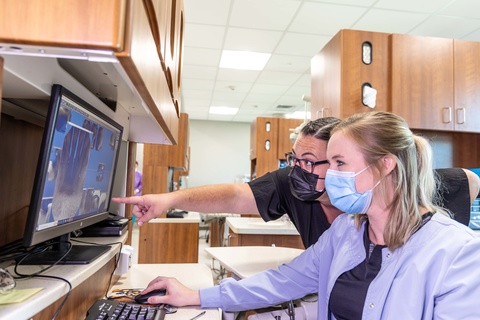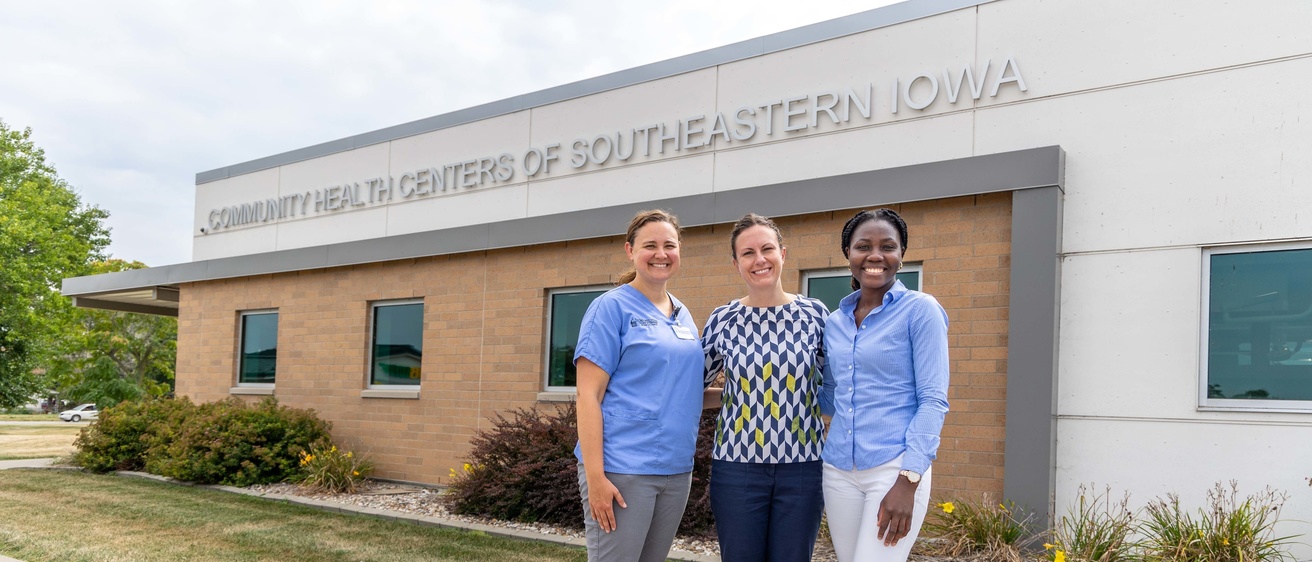As the COVID-19 Pandemic began in 2020, healthcare increasingly used telehealth appointments to screen, diagnose, and prescribe medicine for patients to limit the risk of transmitting COVID-19. As a result, many healthcare clinics began to see the value of telemedicine independently of COVID-19. It can improve access, decrease burdens on providers and patients, and reduce costs.
Prior to this COVID-related expansion of telehealth services, University of Iowa oral health researchers and the Community Health Centers of Southeastern Iowa in Keokuk, Iowa saw that teledentistry presented a unique opportunity to improve access to dental care for underserved Iowans.
Dental Care for Older Adults and Nursing Home Residents
Older adults, including nursing home residents, are an especially underserved population in dentistry.
“It is not very common for older adults, especially those in nursing homes, to get access to dental care,” said Jennifer Hartshorn, clinical associate professor in preventive and community dentistry and an expert in oral health care for older adults. “For this population, transportation is challenging, especially if a wheelchair is involved or if staff assistance is required, and nursing home residents sometimes struggle to make it to appointment if the patient is sick or is simply not having a good day.”
These barriers limit nursing home residents’ access to dental care, and those barriers can be detrimental to their overall health.
“The better their dental health, the more likely that they will be able to continue eating and drinking well, communicating more effectively, and just staying healthier longer,” explained Hartshorn.
And that’s where teledentistry comes in.
Teledentistry in Nursing Homes
A team of University of Iowa oral health researchers and dental providers at the Community Health Centers of Southeastern Iowa teamed up to deliver and assess the effectiveness of teledentistry in a nursing home setting.

In this pilot project, a dental hygienist goes on site to a nursing home and, using portable equipment, collects diagnostic information, including x-rays and photos, for enrolled patients. The hygienist then sends this information to the dentist who uses the information to perform an exam remotely. The hygienist also provides cleanings and other preventive services for residents at the nursing home in a similar way that they would in the dental clinic. Tessa Johnson, a dentist at the Community Health Centers of Southeastern Iowa Keokuk Dental Clinic, reviews the patient information and x-rays and conducts an exam remotely. When follow-up treatment is needed, Johnson’s clinic and the nursing home work together to get the patient scheduled for treatment at the Keokuk clinic.
This teledentistry model, known as the Virtual Dental Home, was developed by Paul Glassman in California over 10 years ago and has been implemented in many other states since. Drawing on the University of Iowa’s expertise in oral health care for older adults and the awareness of the Virtual Dental Home Model in other states, Hartshorn and Julie Reynolds, assistant professor in the Department of Preventive and Community Dentistry, invited Glassman to help the team establish the first Virtual Dental Home Model in the state of Iowa. This model establishes a dental home for patients, including an on-going relationship with a dentist-hygienist team who regularly and routinely provide preventive dental care intended to catch and treat problems before they significantly impact a person’s quality of life.
Hartshorn and Reynolds, in partnership with the Community Health Centers of Southeastern Iowa’s Keokuk Dental Clinic, received a grant from the Delta Dental of Iowa Foundation in February 2020 to implement, and study the impact of, this first-of-its-kind program in the state of Iowa. Though COVID presented initial delays, the team got to work laying the groundwork for the program, including working with Glassman to developing workflows, protocols, selecting and purchasing equipment, and preparing to launch when the COVID-related nursing home closures subsided. The program was successfully launched with two nursing homes in Lee County, Aspire of Donnellson and River Hills Village, in February 2022.
Improving the Health of Iowans in Nursing Homes
Oral health is vital for overall health, especially for older adults. The overall health of a nursing home patient who suffers from oral pain, is unable to eat, or has other related oral health ailments will quickly deteriorate, and many such patients have undiagnosed and untreated dental conditions that could be addressed by appropriate dental care.

This pilot project established a dental home for these patients so that their needs would be consistently and routinely addressed, and it was sorely needed.
“Although about 10% of the patients we saw at the nursing home came into our clinics already, the rest of them (~90%) had not been receiving any dental care,” said Johnson.
Meeting these patients where they are makes them more likely to get the dental care they need.
“The residents are just more comfortable receiving preventive care at the nursing home—it’s their home, and this is especially important for residents who may be struggling with other medical conditions,” said Paige Plagman, the dental services manager for the Community Health Centers of Southeastern Iowa.
And this care makes a difference in the nursing home residents’ lives.
“Keeping a person’s mouth in good working order allows them to continue eating and drinking well, and an opportunity to maintain or even improve their quality of life,” explained Hartshorn.
Future of the Virtual Dental Home in Iowa
The research team at the University of Iowa College of Dentistry is studying the impact of the program on residents’ access to care, as well as implementation successes and challenges for community health centers and nursing home staff. This information will be used to help inform other clinics in Iowa that want to use this model to extend the reach of their clinics into the community.

At a recent conference with other community health center leaders, Johnson discussed the model and what they have been doing with it. Many other community health center dentists were interested in hearing more about the program, and exploring whether the program can be successfully replicated in their dental clinics.
As for Johnson’s clinic: “We are planning to continue the pilot program as a service,” explained Johnson.
Treating dental needs preventively now will reduce the need for more invasive treatments later and reduce future overall health needs that would likely arise without adequate dental care.
But perhaps most importantly, meeting the oral health needs of the most underserved Iowans demonstrates the value and importance of each person in our community. It’s a dignity that all people deserve.
